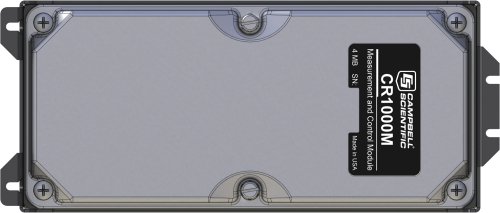This product is not available for new orders.

| Services Available |
|---|
Overview
The CR1000M must be connected to a CR1000WP to function as a complete CR1000 datalogger. It may be purchased separately to replace a lost or damaged module. The CR1000M measures sensors, drives direct communications and telecommunications, reduces data, controls external devices, and stores data and programs in onboard, nonvolatile storage. The electronics are RF shielded and glitch protected by the sealed, stainless-steel canister. A battery-backed clock assures accurate timekeeping.
Read MoreImages

Detailed Description
The CR1000M must be connected to a CR1000WP to function as a complete CR1000 datalogger. It may be purchased separately to replace a lost or damaged module. The CR1000M measures sensors, drives direct communications and telecommunications, reduces data, controls external devices, and stores data and programs in on-board, non-volatile storage. The electronics are RF shielded and glitch protected by the sealed, stainless steel canister. A battery-backed clock assures accurate timekeeping.
The CR1000M can simultaneously provide measurement and communication functions. The on-board, BASIC-like programming language supports data processing and analysis routines.
Originally, the CR1000M had 2 Mbytes of data/program storage, and another product, the CR1000M-4M, was offered that had 4 Mbytes of memory. In September 2007, the standard CR1000M started having 4 Mbytes of memory, making the CR1000M-4M obsolete. Modules with a serial number greater than or equal to 11832 will have a 4 Mbyte memory. The 4 Mbyte modules will also have a sticker on the canister stating "4M Memory".
Specifications
| Dimensions | 21.6 x 10.2 x 3.2 cm (8.5 x 4.0 x 1.25 in.) |
| Weight | 362.9 g (0.8 lb) |
Documents
Compliance
Videos & Tutorials
Downloads
CR1000 OS v.32.07 (4.60 MB) 05-15-2024
Execution of this download installs the CR1000 Operating System and Compiler on your computer. It also updates the CR1000 support files for the CRBasic Editor.
Note: This OS has crossed the 2 Meg CR1000 size limit for remote download. The OS must be downloaded to the 2 Meg CR1000 via direct connect with the Device Configuration Utility. All OS download methods are supported by the 4 Meg CR1000.
Upgrading from versions prior to version 28 of the Operating System will reset the datalogger’s CPU drive. This is due to a change in the format of the file system from FAT16 to FAT32. In order for the datalogger to operate correctly, as part of the upgrade, the CPU drive is formatted to FAT32. Any programs stored and running from the CPU drive will be lost. It is not recommended to update the datalogger’s Operating System over a remote connection where program control regulates the communication equipment (turning it on or off, etc.). In these cases, an on-site visit and a backup using DevConfig’s backup utility is necessary to update the datalogger’s Operating System.
Watch the Video Tutorial: Sending an OS to a Local Datalogger.
In all cases where the datalogger is being updated from an Operating System prior to 28, the use of DevConfig’s backup utility is recommended due to the CPU drive being formatted using the new FAT32 format.
Listed Under
Privacy Policy Update
We've updated our privacy policy. Learn More
Cookie Consent
Update your cookie preferences. Update Cookie Preferences
